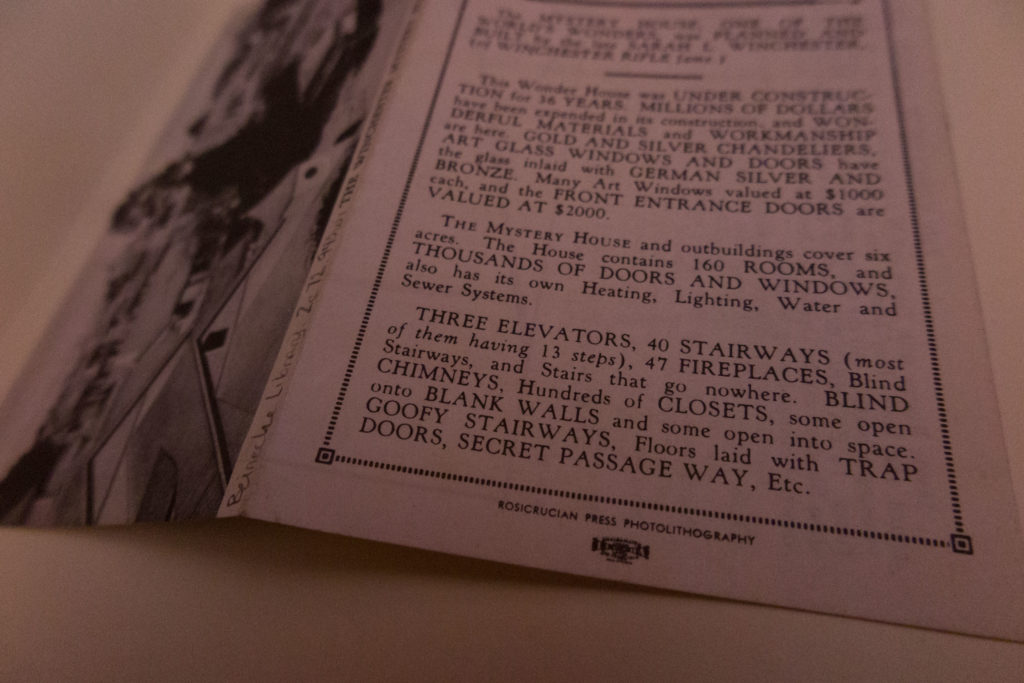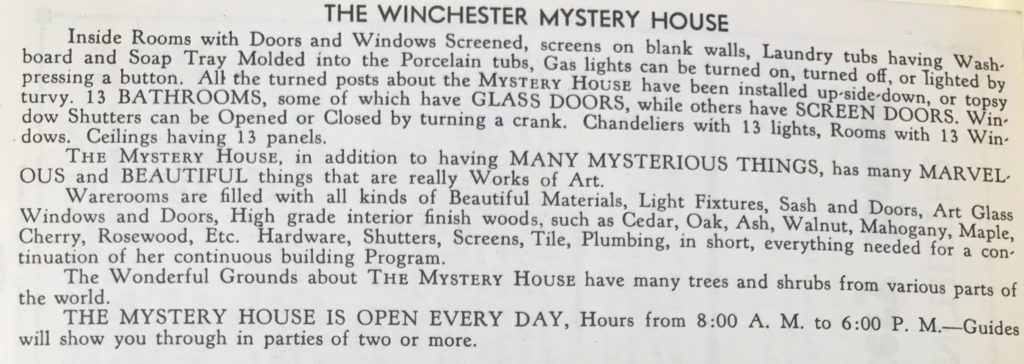Have a drink with: Sarah Winchester
40BR, 30BA; move-in ready!
Ask her about: Extreme Home Makeover, Spectral Edition
You’d be forgiven for thinking that the star of the recent suspense film Winchester is Helen Mirren. She is, after all, a certified badass; a superb actress; and well kitted out for the job in a dour stare and a dramatic swath of black Victorian lace.
In fact, though, the star of the film is a house, purportedly as haunted in reality as it is on film. The Winchester Mystery House, as it’s popularly known, is a 160-room Queen Anne-style mansion in modern-day Silicon Valley, created by the real-life version of Mirren’s character Sarah Winchester. And as a 1940s tourism brochure points out, “The World’s Largest, Oddest Dwelling” is not your typical real estate listing.
So why spend more than three decades building an ooky, nonsensical Queen Anne monstrosity, albeit one with very nice amenities? If you believe the legend, it’s because Sarah Winchester was trying to manage a tenant roster of very unhappy ghosts.
Sarah Winchester was born Sarah Lockwood Pardee in New Haven, Connecticut in the late 1830s and married into the Winchester family, who had revolutionized American firearms manufacture with the Winchester Repeating Arms Company. While the company enjoyed success, the Winchesters’ family life was painful: the couple lost an infant daughter due to disease, and in 1881 Sarah’s husband and company president William Winchester died of tuberculosis at the young age of 43.
Sarah, grief-stricken, took an interest in spiritualism, and allegedly learned from a psychic that she was tagged with a particular piece of karmic bad luck: every soul who had been killed by a Winchester rifle – the very symbol of manifest destiny – was mighty pissed off, and coming after her for revenge. Indeed, her husband and daughter were only just the first taste of a larger curse. She was to move west, and spend the rest of her days building a house to confound and confine the unhappy dead, a house that should never be complete lest she also die. She moved to the San Jose area, purchased a modest farmhouse and spent the remainder of her life expanding it with arcane building projects, eventually creating a 26,000 square-foot hodgepodge of a mansion with some of the weirdest architectural features you’ll ever see: Tiffany windows hidden behind walls, stairways that lead nowhere, turrets, towers and, yes, more than a dozen bathrooms. She allegedly took daily direction from the spirits of Native Americans and Civil War dead, and built continuously on the house until her death in 1922.
So goes the legend, anyway. The fact of the Winchester mansion is far more pedestrian, if still pretty eccentric: Sarah Winchester was not a complete wackjob trying to build an endless succession of nonsensical rooms to give every murdered ghost its individual peace. She was a very moderate wackjob with a family fortune, some high-maintenance relatives living nearby, an obsessive interest in architecture and a lot of grief over the loss of her family.
Rather than moving to California alone, frizzy and superstitious, Sarah in fact was joined by a handful of sisters, who occasionally made her nuts, and in addition to her construction hobby spent time on philanthropy and the real cause that seemed to affect her deeply: she left a large portion of her estate to found a tuberculosis hospital in New Haven, still angry at the disease that had taken her husband decades earlier.
For Sarah Winchester, architecture was a mental occupation and a way she could feel connected to her husband, who enjoyed the pursuit: according to biographer Mary Jo Ignoffo, “Winchester drew up plans, instructed builders, studied manuals, subscribed to journals including the Architectural Record, and did her own rough drafting and design. If the result did not measure up to her expectations, she had it torn down and rebuilt or discontinued, only to resume a completely different and previously abandoned project.”*
The spiritualist stories began during Winchester’s lifetime, with even the New York Times mentioning the house and its alleged spirit world connections in 1911; but thoroughly exploded after her death, when the house became a tourist destination. Historians have consistently endeavored to poke holes in the Winchester myth, not just with details but with the simple fact that it’s altogether too convenient: if Sarah Winchester had been heir to, say, a clock manufacturer, would we claim she was building a strange sprawling house to appease the spirits of anyone who’d ever been late for a meeting?
Fun Facts:
The number 13 does appear an awful lot in the Winchester house, fueling the creepy theories: stairways have 13 steps, there are 13 bathrooms, ceilings with 13 panels. It seems that Sarah Winchester’s alleged preoccupation with the number 13 was largely made up by John and Mayme Brown, a couple who purchased the home only months after Winchester’s death and promptly got to work promoting it as a mysterious tourist attraction (which it remains today). The Browns made convenient modifications and went so far as to invite Harry Houdini for a midnight seance in 1924.
The stairs leading nowhere are not so unusual, argues author Mary Jo Ignoffo: after a serious 1906 earthquake damaged many of the buildings in the area, Sarah Winchester opted for repairs over rebuilding, simply capping off many damaged areas of the building if not ignoring them entirely.
The grounds of the William Wirt Winchester Hospital are currently occupied by the West Haven, Connecticut VA. Yale-New Haven Hospital still maintains the Winchester Chest Clinic for treatment of respiratory disorders.
The California band Count Five shot photos for “Psychotic Reaction” in satin capes on the front lawn of the Winchester house.
Additional Reading:
Becky Ferreira, “The Scariest Part of the Winchester Mansion Has Nothing to Do With Ghosts,” Vice, October 31, 2017
Colin Dickey, “What Winchester Gets Wrong About an American Landmark,” New Republic, February 7, 2018
*Mary Jo Ignoffo, Captive of the Labyrinth (2010)

